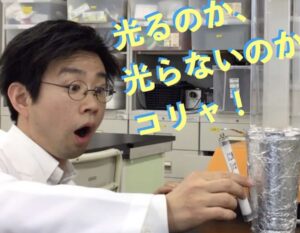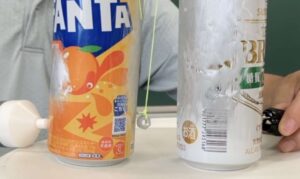Planetary Power in Your Hand: The Shocking Science of the Iron Rod Magnet
I’m Ken Kuwako, a Science Trainer. Every Day is an Experiment!
Imagine turning a plain iron rod into a magnet just by hitting it with a hammer—wouldn’t you call that magic? I recently gave a lecture in Nagano Prefecture after being invited by the Physical and Chemical Society.
While I was there, I saw another researcher’s presentation on this exact experiment: “Turn an iron rod into a magnet just by hammering it!” I was genuinely astonished. As soon as I got home, I had to try it myself, and sure enough, it really worked! The students were completely amazed, too, shouting, “No way!” when I demonstrated it for them. This is such a fascinating and educational experiment, so I’m excited to share it with you!
Make a Magnet with a Hammer! The “Geomagnetic Compass” Experiment
What You’ll Need
An iron rod (about 50cm/20 inches), a compass, a hammer
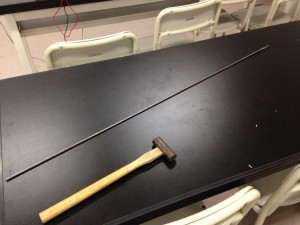
Experiment Procedure
0. The Control: First, bring the iron rod close to the compass. The compass needle should barely move (or not move at all). This confirms the rod is not currently a magnet.
1. Align with the Field: Hold one end of the iron rod and point the opposite end toward North. The key is to tilt the North-facing tip down toward the ground slightly. This aligns the rod with the direction of the Earth’s magnetic field (geomagnetism). (Check North with your compass, and then tilt the rod’s tip down as if it’s bowing.)
2. Give it a Whack! Take the end you are holding (the South-facing end) and firmly strike it about three times with the hammer.
3. Check for Magnetism (N-Pole): Bring the tip of the rod (the one you pointed North) close to the compass. What happens? The compass’s South pole should be attracted to the rod, confirming the tip is now the North pole of a magnet!
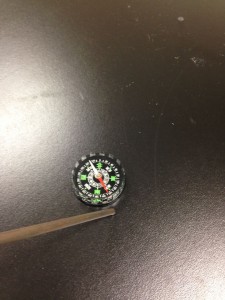
4. The Pole Reversal (Bonus Experiment): Now, point the newly-formed North pole end toward “South,” and the end you held in your hand toward “North.” Strike the new South-facing end again. Bring the end that was just the N-pole near the compass… This time, the compass’s North pole should be attracted to it, meaning the rod has reversed polarity and is now the S-pole (or it repels the N-pole, which is also correct)!
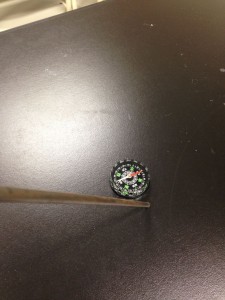
5. Demagnetization: Finally, point the iron rod East-West (a direction not aligned with the Earth’s magnetic field) and strike it several times in the same way. You should observe that the rod’s magnetic field weakens (it becomes demagnetized).
That’s the experiment!
The Secret Revealed: Why Does Hammering Create a Magnet?
Why does striking the rod with a hammer (applying a vibration) cause it to become magnetized?
The truth is, iron is full of countless, tiny “seeds of magnetism”—which are technically called “magnetic domains.” Normally, these domains are pointing in random directions, canceling each other’s magnetic forces out. This leaves the iron rod with no overall magnetic power. (This is the state in Procedure 0.)
However, when you orient the iron rod in the direction of the Earth’s magnetic field (geomagnetism) and give it a strong, sharp hit with the hammer (applying vibration), the randomly oriented magnetic domains become loosened and easier to move. Guided by the Earth’s magnetic force, they all snap into alignment in the same direction!
When the magnetic domains align, the entire iron rod suddenly possesses magnetic power. That’s how it works!
The Earth is a Giant Magnet
The planet we live on, Earth, is itself a massive magnet. (That’s why a compass needle points North!) This experiment essentially involves using the Earth’s invisible magnetic force (geomagnetism) to align the tiny magnets within the iron rod.
This is also why, as shown in Procedure 5, striking the rod while pointing it East-West (a direction unrelated to the Earth’s magnetic field) causes the aligned magnetic domains to become scrambled again, weakening the magnetization.
You might find it hard to believe that “the Earth’s magnetic field can do that!” But it really works. It’s an incredibly cool and thought-provoking experiment that connects an ordinary iron rod in your hand to a planetary-scale force. Be sure to try it at home!
Inquiries and Requests
I’m here to bring the wonder and fun of science closer to you! I put together easy-to-understand explanations of exciting, at-home science experiments and tips. Feel free to explore and search for more!
The content from this science blog is now available as a book. Find out more here.
Learn more about the administrator, Ken Kuwako, here.
For various requests (writing, lectures, science workshops, TV supervision, appearances, etc.), click here. – Updates on articles are posted on X!
![]() We post experiment videos on the Science Neta Channel!
We post experiment videos on the Science Neta Channel!

